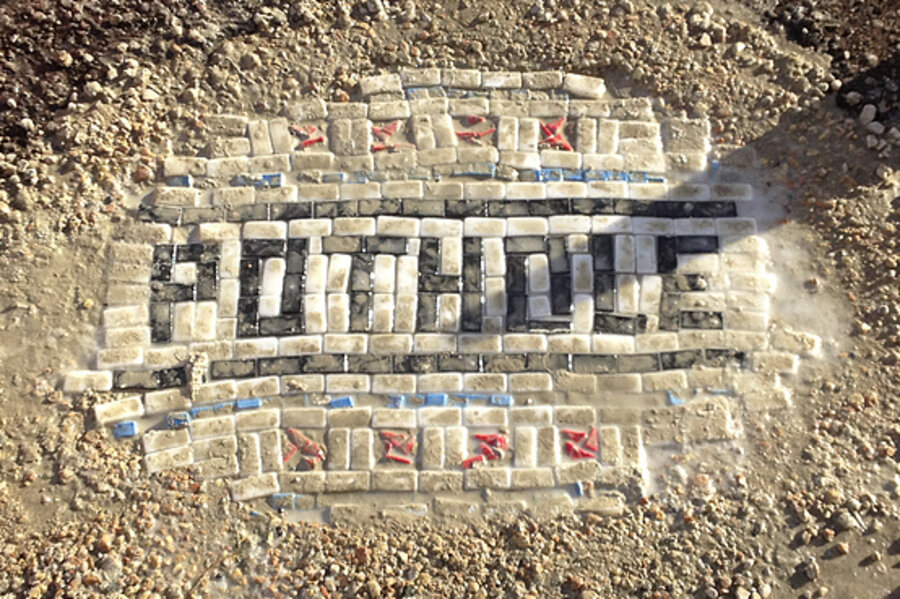Getting filled in on the art of dealing with potholes
Loading...
As the polar vortex take one more pass over roads in the Northeast, attention turns to the issue of the resulting potholes that infuriate drivers and, in some US cities, inspire artists.
A new study from the American Automobile Association reveals that pothole damage has cost US drivers $15 billion in vehicle repairs over the past five years, or approximately $3 billion annually. A report from national transportation research group The Road Information Project (TRIP) adds that driving on deteriorated urban roads costs motorists as much as $1,044 annually.
Perhaps that explains why some art lovers who are sick of car repairs have funded a Kickstarter campaign by Chicago artist Jim Bachor to the tune of nearly $14,000 to fill unsightly craters in city streets with his clever mosaic artworks.
Two years ago, Mr. Bachor gained national acclaim for his guerilla art campaign, the Pothole Project series, that began in the summer of 2013 as a way to turn his personal frustration into something lighthearted that the public could appreciate.
Bachor sees Chicago potholes as opportunities to fill with stone and glass mosaics of flowers, humor, and occasionally pothole-related contact information.
“I decided to fill some of the holes with the phone numbers of really good car repair places,” Bachor said in a phone interview from his Chicago home. “I figured people would really appreciate those.”
Rather than halting his efforts, the city of Chicago has taken a live-and-let-live approach, Bachor said.
The series began almost three years ago with each filled hole simply bearing the words “Pot Hole” spelled out in colorful stone and glass tiles with various representations of the Chicago city flag as the background.
Other cities have seen residents take unique approaches with potholes, as well. For example, in Corpus Christi, Texas “potted potholes” are popping up this spring as some anonymous resident has filled the gaps with soil and flowers in the middle of the roads.
The website My Potholes features photos by conceptual photographer and filmmaker Davide Luciano and professional food stylist Claudia Ficca that convert the unsightly blemishes to whimsical happenings.
The photos use street cracks and craters in New York City, Los Angeles, Toronto, and Montreal as a tongue-in-cheek collection that ranges from the rabbit hole Alice is about to enter, to an infant’s baptismal font.
Others would prefer to simply see the roads mended, however, even if they have to run around them in a race to raise the funds themselves. On March 19, residents of Whitney, Texas, tweeted about the annual Pothole Run.
“The artwork is helpful in terms of bringing attention to the issue,” says Carolyn Kelly, associate director for research and communication at TRIP in an interview.
Ms. Kelly adds that “Americans to travel more than 2 trillion miles annually. But conditions on the system are deteriorating, as the need for transportation improvements far outpaces the amount of state and federal funding available.”
In December 2015, Congress passed, and the president signed into law, the Fixing America’s Surface Transportation Act (FAST Act) a long-term federal surface transportation program that includes modest funding increases and allows state and local governments to plan and finance projects with greater certainty through 2020.
FAST provides approximately $305 billion for surface transportation with highway and transit funding slated to increase by approximately 15 percent and 18 percent, respectively, over the five-year duration of the program, according to TRIP.
According to TRIP, the FAST Act “is a step in the right direction, the funding falls far short of the level needed to improve conditions and meet the nation’s mobility needs and fails to deliver a sustainable, long-term source of revenue for the federal Highway Trust Fund.
“Our hope is that the public realizes not just that there are potholes out there but what affect that has on the quality of life and the affects that it has on their wallets every year," Kelly adds. "We hope that through the efforts of this artist [Jim Bachor] and others that the message will go out and legislators will do something about the condition of the transportation system.”








